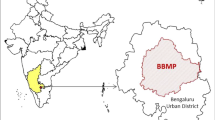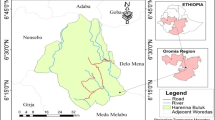Abstract
Healthy rangelands are of economic and biodiversity conservation importance in the savannas of northern South Africa. The proliferation of woody plant species on the rangelands, known as bush encroachment, constitutes a degradation of rangeland quality, given the non-palatability of the encroaching species. Though the causes are not fully understood, heavy grazing and fire suppression are thought to be primary causes of bush encroachment. This study utilised multitemporal (1994, 2000 and 2008) SPOT images of two rangeland sites in Mokopane, South Africa in monitoring and assessing bush encroachment. The study sites were a fenced biodiversity conservation rangeland with game species in which fire is suppressed and an open access communal rangeland grazed by livestock. Field plot-derived encroachment categories of heavy encroachment, moderate encroachment, low encroachment and non-encroached were used in hybrid classification of the images, following radiometric normalisation and geometric registration. GIS overlay analysis using the non-encroached category enabled the quantification and mapping of change in the preferable open grass rangeland typifying savannas. The biodiversity conservation area was undergoing a trend of reduction in open grass rangeland, whereas the communal rangelands were getting more opened up by livestock trampling. Rangeland management practices of fire utilisation, stocking levels and stock concentration account for the differing trends. Lightly grazed and heavily grazed wild game-utilised rangelands under a fire suppression rangeland management regime had bush encroachment rates of approximately 34% and 56%, respectively, in 6 years. Multitemporal remote sensing proved to be useful for monitoring bush encroachment as indicator of state of savanna rangelands.
Similar content being viewed by others
References
Archer, S. (1995). Tree-grass dynamics in a Prosopis-thornscrub savanna parkland: Reconstructing the past and predicting the future. Ecoscience, 2, 83–99.
Brandt, J. S., & Townsend, P. A. (2006). Land use–land cover conversion, regeneration and degradation in the high elevation Bolivian Andes. Landscape Ecology, 21, 607–623.
Brits, J., van Rooyen, M. W., & van Rooyen, N. (2002). Ecological impact of large herbivores on the woody vegetation at selected watering points on the eastern basaltic soils in the Kruger National Park. African Journal of Ecology, 40, 53–60.
Buchanan, G. M., Butchart, S. H. M., Dutson, G., Pilgrim, J. D., Steininger, M. K., Bishop, D. K., et al. (2008). Using remote sensing to inform conservation status assessment: Estimates of recent deforestation rates on New Britain and the impacts upon endemic birds. Biological Conservation, 141, 56–66.
Clarke, P. E., Seyfried, M. S., & Harris, B. (2001). Intermountain plant community classification using Landsat TM and SPOT HRV data. Journal of Range Management, 54, 152–160.
Coppin, P., Jonckheere, I., Nackaerts, K., Muys, B., & Lambin, E. (2004). Digital change detection methods in ecosystem monitoring: A review. International Journal of Remote Sensing, 25, 1565–1596.
Dean, W. R. J., & MacDonald, I. A. W. (1994). Historical changes in stocking rates of domestic livestock as a measure of semi-arid and arid rangeland degradation in the Cape Province, South Africa. Journal of Arid Environments, 26, 281–298.
Hall, F. G., Strebel, D. E., Nickeson, J. E., & Goetz, S. J. (1991). Radiometric rectification: Toward a common radiometric response among multidate, multisensor images. Remote Sensing of Environment, 35, 11–27.
Hudak, A. T., & Wessman, C. A. (1998). Textural analysis of historical aerial photography to characterise woody plant encroachment in South African savanna. Remote Sensing of Environment, 66, 317–330.
Hudak, A. T., & Wessman, C. A. (2001). Textural analysis of high resolution imagery to quantify bush encroachment in Madikwe Game Reserve, South Africa, 1955–1996. International Journal of Remote Sensing, 14, 2731–2740.
Jensen, J. R. (2005). Introductory digital image processing: A remote sensing perspective (3rd ed.). Eaglewood Cliffs: Prentice Hall.
Jordaan, J. J. (1995). The short-term effect of fire on the woody component of the sourish mixed bushveld. African Journal of Range and Forage Science, 12, 128–130.
Kraaij, T., & Ward, D. (2006). Effects of rain, nitrogen, fire and grazing on tree recruitment and early survival in bush-encroached savanna, South Africa. Plant Ecology, 186, 235–246.
Laliberte, A. S., Rango, A., Havstad, K. M., Paris, J. F., Beck, R. F., McNeely, R., et al. (2004). Object-oriented image analysis for mapping shrub encroachment from 1937 to 2003 in southern New Mexico. Remote Sensing of Environment, 93, 198–210.
Lillesand, T. M., Kiefer, R. W., & Chipman, J. W. (2008). Remote sensing and image interpretation (6th ed.). New York: Wiley.
Lu, D., Mausel, P., Brondizio, E., & Moran, E. (2004). Change detection techniques. International Journal of Remote Sensing, 20, 2365–2407.
Martin, R. E., & Asner, G. P. (2005). Regional estimate of nitric oxide emissions following woody encroachment: Linking imaging spectroscopy and field studies. Ecosystems, 8, 33–47.
Meygret, A. (2005). Absolute calibration: From SPOT1 to SPOT5. In J. J. Butler (Ed.), Proceedings of SPIE (Vol. 5882). Bellingham: SPIE.
Moleele, N. M., Ringrose, S., Matheson, W., & Vanderpost, C. (2002). More woody plants? The status of bush encroachment in Botswana’s grazing areas. Journal of Environmental Management, 64, 3–11.
Mouat, D. A., Mahin, G. G., & Lancaster, J. (1993). Remote sensing techniques in the analysis of change detection. Geocarto International, 2, 39–50.
Myburgh, W., Malan, R., & Reilly, B. (2008). Vegetation classification, description and mapping of the Mokopane biodiversity conservation centre. Centurion: Ecofin Consulting Ecologists.
Nangula, S., & Oba, G. (2004). Effects of artificial water points on the Oshana ecosystem in Namibia. Environmental Conservation, 31, 47–54.
O’Connor, T. G., & Crow, V. R. T. (1999). Rate and pattern of bush encroachment in Eastern Cape savanna and grassland. African Journal of Range and Forage Science, 16, 26–31.
Roques, K. G., O’Connor, T. G., & Watkinson, A. R. (2001). Dynamics of shrub encroachment in an African savanna: Relative influences of fire, herbivory, rainfall and density dependence. Journal of Applied Ecology, 38, 268–280.
Schott, J., Salvaggio, C., & Volchok, W. (1988). Radiometric scene normalisation using pseudo invariant features. Remote Sensing of Environment, 26, 1–16.
Serra, P., Pons, X., & Sauri, D. (2003). Post-classification change detection with data from different sensors: Some accuracy considerations. International Journal of Remote Sensing, 24, 3311–3340.
Siddiqui, Y. (2003). The modified IHS method for fusing satellite imagery. In Proceedings of the ASPRS 2003 annual conference.
Skarpe, C. (1992). Dynamics of savanna ecosystems. Journal of Vegetation Science, 3, 293–300.
Song, C., Woodcock, C. E., Seto, K. C., Lenney, M. P., & Macomber, S. A. (2001). Classification and change detection using Landsat TM data: When and how to correct atmospheric effects? Remote Sensing of Environment, 75, 230–244.
Trollope, W. S. W., Trollope, L. A., & Hartnett, D. C. (2002). Fire behaviour a key factor in the fire ecology of African grasslands and savannas. In X. Viegas (Ed.), Forest fire research & wildland fire safety (pp. 1–15). Rotterdam: Millpress.
van Vegten, J. A. (1983). Thornbush invasion in a savanna ecosystem in eastern Botswana. Plant Ecology, 56, 3–7.
Ward, D. (2005). Do we understand the causes of bush encroachment in African savannas? African Journal of Range and Forage Science, 22, 101–105.
Author information
Authors and Affiliations
Corresponding author
Rights and permissions
About this article
Cite this article
Munyati, C., Shaker, P. & Phasha, M.G. Using remotely sensed imagery to monitor savanna rangeland deterioration through woody plant proliferation: a case study from communal and biodiversity conservation rangeland sites in Mokopane, South Africa. Environ Monit Assess 176, 293–311 (2011). https://doi.org/10.1007/s10661-010-1583-4
Received:
Accepted:
Published:
Issue Date:
DOI: https://doi.org/10.1007/s10661-010-1583-4




